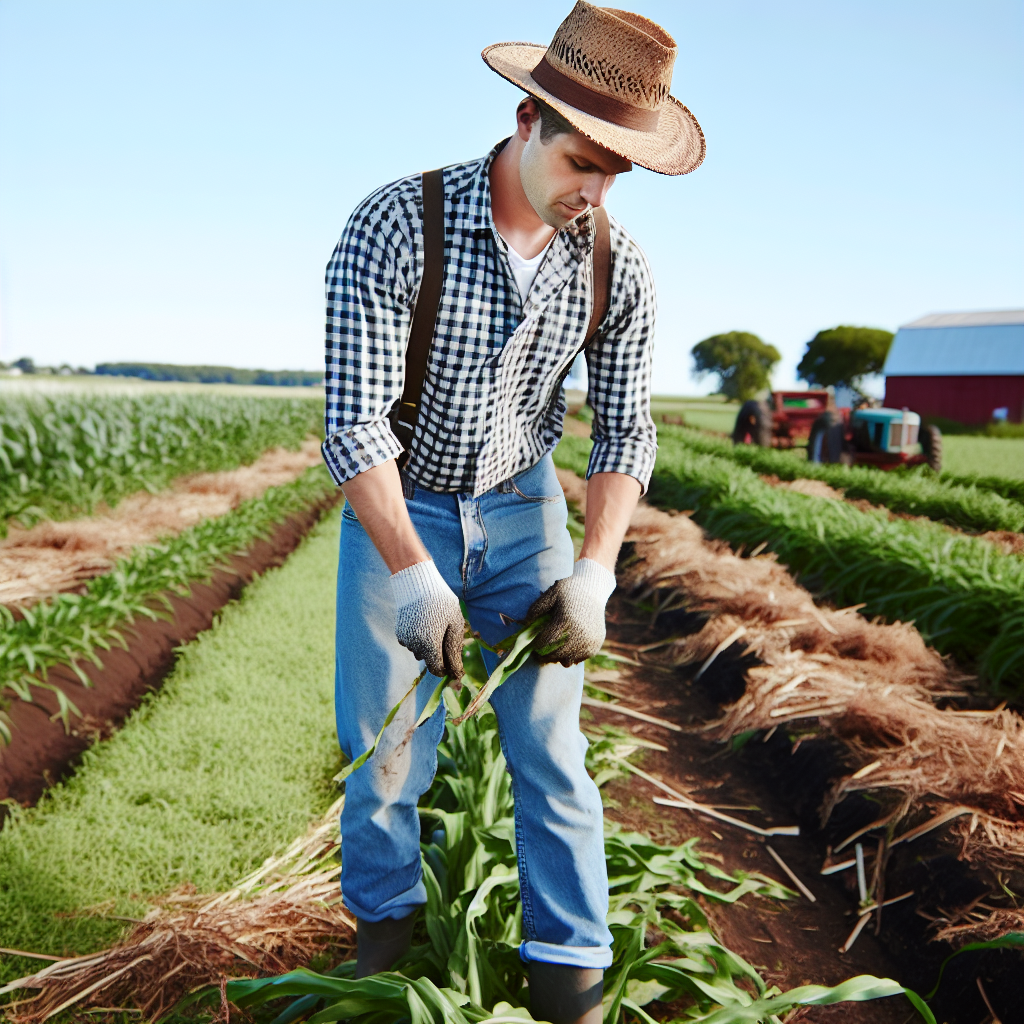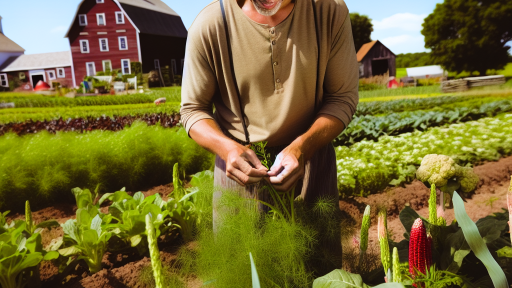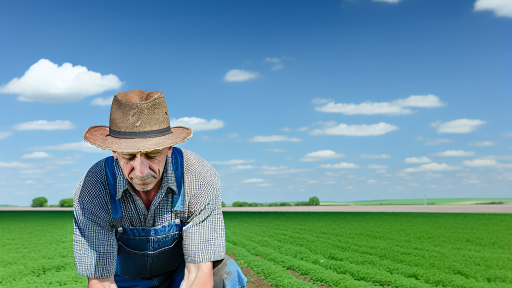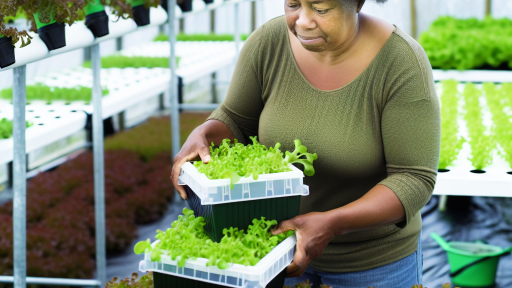Introduction to Mulching
Definition of Mulching
Mulching refers to the practice of covering the soil around plants.
This technique offers numerous benefits for crop cultivation.
Importance in Crop Cultivation
Mulching plays a vital role in improving soil health.
It helps retain moisture and regulate soil temperature.
Additionally, mulching prevents weed growth effectively.
This reduces competition for water and nutrients.
Moreover, organic mulches decompose over time, enriching the soil.
They contribute to soil structure and fertility.
Benefits of Mulching
- Enhances moisture retention.
- Controls soil temperature fluctuations.
- Suppresses weed growth.
- Promotes beneficial microorganisms in the soil.
Types of Mulch
Various types of mulch exist, each with unique properties.
Organic mulches include grass clippings, leaves, and straw.
These materials decompose, adding nutrients back to the soil.
Inorganic mulches, such as gravel and plastic, do not decompose.
They offer long-lasting benefits but do not enhance soil fertility.
Benefits of Implementing Mulching Practices
Incorporating mulching into crop cultivation can yield significant advantages.
This practice ultimately contributes to more sustainable farming methods.
Transform Your Agribusiness
Unlock your farm's potential with expert advice tailored to your needs. Get actionable steps that drive real results.
Get StartedTypes of Mulches: Organic vs. Inorganic and Their Benefits
Understanding Organic Mulches
Organic mulches consist of natural materials.
Examples include straw, wood chips, and grass clippings.
These materials break down over time, enriching the soil.
Organic mulches improve moisture retention.
They also suppress weed growth effectively.
Additionally, they provide habitat for beneficial organisms.
Organic mulches enhance soil temperature regulation.
They contribute to a sustainable farming ecosystem.
Exploring Inorganic Mulches
Inorganic mulches are made from synthetic materials.
Common types include plastic sheets and landscape fabric.
These materials do not decompose like organic ones.
Inorganic mulches effectively control weed growth.
They also promote heat retention during cooler weather.
Moreover, they can enhance soil structure long-term.
Inorganic mulches require less maintenance compared to organic options.
Benefits of Organic Mulches
Organic mulches naturally enrich the soil as they decompose.
They enhance soil fertility by adding essential nutrients.
Additionally, organic mulches support diverse ecosystems.
These mulches can be made from readily available materials.
They are environmentally friendly and easy to implement.
Benefits of Inorganic Mulches
Inorganic mulches provide long-lasting solutions for weed control.
They reduce the need for frequent maintenance and replacement.
Moreover, they ensure better waterproofing of the soil.
Inorganic mulches also come in various colors and textures.
Showcase Your Farming Business
Publish your professional farming services profile on our blog for a one-time fee of $200 and reach a dedicated audience of farmers and agribusiness owners.
Publish Your ProfileThis variety allows for enhanced aesthetic appeal in gardens.
Choosing the Right Mulch for Your Crops
Selecting the right type of mulch depends on crop needs.
Consider local climate and soil conditions when choosing.
Organic mulches work well in promoting healthy soil.
Inorganic mulches are ideal for maximizing efficiency.
Evaluate the long-term benefits and maintenance required.
Ultimately, the right choice impacts the overall yield.
Selecting the Right Mulch for Different Crop Types
Understanding Mulch Types
Mulch comes in various forms, each offering distinct benefits.
Organic mulches include straw, grass clippings, and wood chips.
Inorganic mulches can be rubber, plastic, or landscape fabric.
Choosing the right type depends on the specific needs of your crops.
Vegetable Crops
Vegetable crops thrive with organic mulches like straw or shredded leaves.
These materials help retain soil moisture and suppress weeds.
Furthermore, they break down over time, enriching the soil.
Avoid using thick plastic mulch for deep rooting vegetables.
Fruit Crops
For fruit crops, organic mulch is ideal for moisture retention.
Bark chips or cocoa hulls provide excellent protection against weeds.
Moreover, they enhance soil structure as they decompose.
However, ensure good air circulation to prevent fruit rot.
Grain Crops
Grain crops benefit from straw or hay mulch in their early growth stages.
This type limits soil erosion and minimizes moisture loss.
Consider tilling the mulch under post-harvest to improve soil health.
Crop rotation following grain harvest can enhance productivity.
Flowering Plants
Flowering plants often prefer organic mulches for added aesthetics.
Wood chips or shredded bark create visually pleasing beds.
These materials also provide essential nutrients as they decay.
Ensure even distribution around the plants for optimal benefits.
Considerations for Mulch Application
The climate influences the type of mulch you should select.
Hot climates might favor materials that retain moisture well.
Cooler areas may benefit from mulches that provide insulation.
Timing is crucial; apply mulch after the soil has warmed adequately.
Explore Further: Innovative Mulching Approaches for Large-Scale Farms
The Process of Applying Mulch: Techniques and Best Practices
Understanding the Importance of Mulching
Mulching offers numerous benefits to crop cultivation.
It helps conserve soil moisture effectively.
Furthermore, it suppresses weed growth and reduces soil erosion.
Additionally, mulch can improve soil fertility over time.
Selecting the Right Type of Mulch
Choosing the right mulch type is crucial for success.
Organic mulches include straw, wood chips, and grass clippings.
These materials break down and enrich the soil.
Inorganic mulches such as plastic film provide different benefits.
Showcase Your Farming Business
Publish your professional farming services profile on our blog for a one-time fee of $200 and reach a dedicated audience of farmers and agribusiness owners.
Publish Your ProfileEvaluating Organic Mulches
Organic mulches decompose, offering nutrients to plants.
They also enhance soil structure gradually.
However, they require replenishing every season.
Examining Inorganic Options
Inorganic mulches last longer than organic varieties.
They help maintain consistent soil temperatures.
Many gardeners use black plastic or landscape fabric.
Preparing the Soil for Mulching
Proper soil preparation enhances mulch effectiveness.
Begin by clearing the area of weeds and debris.
Next, ensure the soil is well-aerated and loose.
Consider adding compost to enrich the soil.
Applying Mulch Properly
Applying mulch requires careful attention to technique.
First, spread a 2-4 inch layer of mulch around plants.
Leave some space around plant stems to prevent rot.
Maintain consistent coverage for the best results.
Watering After Mulching
Water your garden after applying mulch.
This step helps settle the mulch into place.
It also allows moisture to reach the soil underneath.
Maintaining Mulch Throughout the Growing Season
Regular maintenance ensures mulch remains effective.
Check for gaps and replenish mulch as needed.
Monitor moisture levels in the soil, adjusting as necessary.
Periodic removal of weeds will enhance mulch performance.
Benefits of Organic Mulch Decomposition
As organic mulch decomposes, it improves soil health.
It increases microbial activity and enhances nutrient availability.
Consequently, crops often produce higher yields.
Discover More: Optimizing Yield With Advanced Crop Analytics Tools
Impact of Mulching on Soil Moisture Retention and Temperature
Enhancing Soil Moisture Retention
Mulching significantly increases soil moisture retention.
This practice reduces evaporation from the soil surface.
Moreover, it keeps the soil cooler, promoting moisture conservation.
Organic mulches, like straw or wood chips, are especially effective.
These materials break down over time, improving soil structure.
As a result, water-holding capacity also increases.
Farmers can observe minimized irrigation frequency with mulching.
Ultimately, this leads to reduced water usage and costs.
Regulating Soil Temperature
Mulching plays a crucial role in regulating soil temperature.
It insulates the soil against extreme heat and cold.
This insulation fosters a more stable environment for roots.
Consequently, plants grow better under consistent temperatures.
During hot seasons, mulch shades the soil surface.
This protects delicate plant roots from direct heat exposure.
In colder months, it prevents frost penetration into the soil.
Showcase Your Farming Business
Publish your professional farming services profile on our blog for a one-time fee of $200 and reach a dedicated audience of farmers and agribusiness owners.
Publish Your ProfileThus, mulching extends the growing season for several crops.
Types of Mulching Materials
Selecting the right mulching material is essential.
Organic options include bark, straw, and grass clippings.
These materials decompose, enriching the soil over time.
On the other hand, inorganic mulches like plastic offer durability.
Plastic mulches effectively suppress weeds and retain heat.
Choosing a mulching material depends on specific crop needs.
Farmers should consider local climate and soil conditions.
Overall, each option has distinct advantages and use cases.
Find Out More: Integrating Cover Crops into Crop Rotation Plans
Weed Suppression through Mulching: Mechanisms and Effectiveness
Introduction to Mulching and Weed Suppression
Mulching plays a vital role in crop cultivation.
It primarily aids in controlling weeds effectively.
This technique offers numerous benefits for farmers.
Understanding its mechanisms helps in better implementation.
How Mulching Suppresses Weeds
Mulching inhibits weed seed germination.
This occurs by blocking sunlight from reaching the soil.
Additionally, organic materials decompose, enriching the soil.
This creates conditions unfavorable for weed growth.
Types of Mulch and Their Effectiveness
- Organic mulch consists of materials like straw, wood chips, and grass clippings.
- Inorganic mulch includes plastic, landscape fabric, or rubber.
Each type of mulch has unique advantages.
Organic mulches help in moisture retention.
Conversely, inorganic mulches tend to last longer.
Understanding their traits ensures optimal selection.
Comparative Analysis of Different Mulches
Organic mulches provide excellent weed suppression.
They also enhance biodiversity in the soil ecosystem.
Plastic mulch offers a long-term solution for serious weed problems.
It also warms the soil, benefiting early crop growth.
Choosing the right mulch depends on specific cultivation needs.
Impact of Mulching on Crop Yields
Studies show that effective mulching boosts crop yields.
By reducing competition for resources, plants thrive better.
Furthermore, healthier plants can resist pests and diseases more easily.
This ultimately leads to improved agricultural sustainability.
Potential Challenges of Using Mulch
While mulching has many benefits, it is not without challenges.
Improperly applied mulch can lead to moisture retention issues.
Weed seeds can still germinate if the mulch layer is too thin.
Continuous monitoring ensures the mulch remains effective.
Proper Mulching Practices to Enhance Crop Cultivation
Adopting proper mulching practices enhances weed control.
Farmers should carefully select mulch types based on their needs.
Regular assessment of mulch performance is essential.
Ultimately, effective mulching contributes to successful crop cultivation.
You Might Also Like: Implementing Pest Forecasting In Crop Management Plans
Showcase Your Farming Business
Publish your professional farming services profile on our blog for a one-time fee of $200 and reach a dedicated audience of farmers and agribusiness owners.
Publish Your Profile
Mulch Decomposition: Nutrient Recycling and Soil Health Benefits
Understanding Mulch Decomposition
Mulch decomposition plays a crucial role in soil health.
As organic materials break down, they release nutrients into the soil.
Microorganisms, fungi, and bacteria are essential for this process.
They work collectively to break down complex organic materials.
Healthy microbial activity improves soil structure and fertility.
Nutrient Recycling through Decomposition
Nutrient recycling starts with the breakdown of mulch materials.
Carbon, nitrogen, and other essential nutrients are released gradually.
This slow release is beneficial for plant growth.
Plants can absorb these nutrients when needed.
Moreover, this process reduces the need for synthetic fertilizers.
Benefits for Soil Health
Healthy soil is rich in organic matter from decomposed mulch.
This organic matter improves moisture retention in the soil.
Increased soil moisture is vital during dry periods.
Furthermore, mulch enhances soil aeration and drainage.
Good aeration promotes root growth and microbial activity.
Enhancing Biodiversity
Incorporating mulch supports biodiversity in the soil ecosystem.
Decomposed mulch provides habitat for beneficial soil organisms.
These organisms interact actively with plant roots.
Additionally, they aid in disease suppression and pest control.
This collaborative environment leads to healthier crops.
Implementing Effective Mulching Practices
To maximize benefits, select the right mulch type for your soil.
Consider using materials like straw, leaves, or grass clippings.
Layer thickness should balance insulation and moisture retention.
Regular monitoring ensures that the mulch decomposes efficiently.
Adjusting the mulch application based on seasonal changes is crucial.
Common Challenges and Solutions in Mulching Practices
Managing Weed Growth
Weed competition can hinder crop growth significantly.
Fortunately, mulching effectively suppresses weed emergence.
Use organic mulches such as straw or wood chips.
These materials obstruct sunlight and inhibit weed germination.
Regularly replenish the mulch layer to maintain its effectiveness.
Water Retention and Soil Moisture
Maintaining soil moisture is crucial for crop health.
Mulching helps retain moisture by reducing evaporation rates.
Select moisture-retaining mulches like coir or bark.
These options absorb and hold water effectively.
Additionally, monitor the moisture levels regularly.
Ssoil Temperature Control
Ssoil temperature impacts seed germination and growth rates.
Mulching can help moderate temperature fluctuations.
Use dark-colored mulches to enhance soil warming in cooler climates.
Conversely, lighter mulches keep soils cooler in hot regions.
Adjust your mulch type based on the season and climate.
Showcase Your Farming Business
Publish your professional farming services profile on our blog for a one-time fee of $200 and reach a dedicated audience of farmers and agribusiness owners.
Publish Your ProfileDecomposition and Nutrient Cycling
Organic mulches decompose over time, enriching soil fertility.
However, excessive decomposition can lead to nutrient depletion.
Balance your mulch selection with plant nutrient needs.
Incorporate cover crops to improve nutrient cycling.
This practice complements mulching and boosts soil health.
Insect and Pest Management
Mulching may attract certain pests, affecting crops negatively.
Use insect-resistant mulches to mitigate this issue.
Regularly scout for insect presence around your mulch areas.
Create habitat niches for beneficial insects as well.
These can act as natural pest control agents.
Cost-Effectiveness of Mulching
Initial investment in mulch materials can be high.
But, the long-term benefits outweigh the upfront costs.
Consider using local, biodegradable materials to save money.
Repurposing yard waste into mulch is both cost-effective and sustainable.
Analyze your budget to optimize your mulching strategy.
Case Studies: Successful Mulching Applications in Various Crop Systems
Vegetable Farming Implementation
In vegetable farming, mulching enhances crop yields significantly.
Farmers have reported improved moisture retention due to organic materials.
Specifically, Susan’s Organic Farm utilizes straw as a mulch layer.
This practice reduces weed growth and increases soil temperature.
Consequently, her tomatoes showcased better growth during the summer months.
Cereal Crops Experience
Cereal crops benefit remarkably from mulching in diverse environments.
For instance, Johnson Farms employs shredded paper mulches for wheat.
This method promotes soil moisture and minimizes erosion after rain.
Moreover, this reduces the need for chemical weed inhibitors.
As a result, their yields have increased by approximately 15%.
Fruit Orchard Strategies
Fruit orchards gain substantial advantages from proper mulching techniques.
At Green Valley Orchard, wood chips serve as effective mulch material.
This strategy helps maintain consistent soil temperature for apples.
In addition, it promotes beneficial microorganisms in the soil.
Furthermore, pests become less prominent with this natural barrier.
Research Findings
Numerous studies validate the effectiveness of mulching in agriculture.
Research conducted by the Agricultural Institute in Virginia supports this claim.
The study involved diverse crop systems utilizing various mulch types.
Results indicated that all test groups experienced enhanced soil health.
Moreover, crop resilience improved significantly in mulched fields.
Community Outreach Programs
Local farming communities now embrace mulching techniques actively.
Organizations like FarmSmart conduct workshops to educate growers.
These programs present hands-on demonstrations of effective mulching.
Participants actively engage in techniques using grasses and biodegradable materials.
This initiative successfully empowers farmers to improve productivity.
Showcase Your Farming Business
Publish your professional farming services profile on our blog for a one-time fee of $200 and reach a dedicated audience of farmers and agribusiness owners.
Publish Your ProfileBest Practices and Recommendations for Effective Mulching
Choosing the Right Mulch Material
Selecting appropriate mulch material is crucial for successful crop cultivation.
Consider organic options like straw, grass clippings, and wood chips.
Utilizing inorganic materials such as landscape fabric and rocks can also be beneficial.
Match the mulch type to the specific needs of your crops.
For example, heavier mulches provide better weed suppression.
On the other hand, lighter material allows more water penetration.
Applying Mulch Correctly
Application technique significantly affects mulch effectiveness.
Spread mulch evenly around plants, avoiding direct contact with stems.
Maintain a depth of about 2-4 inches for optimal results.
Ensure proper moisture retention and weed suppression with this depth.
Adjust mulch placement based on the local climate.
In arid regions, thicker layers help reduce evaporation.
Timing for Mulching
Timing plays a vital role in the success of mulching.
Apply mulch after the soil warms up in spring.
This timing promotes root growth while preventing weeds.
Avoid mulching during heavy rains to prevent soil compaction.
Reapply mulch as needed throughout the growing season.
Maintaining Mulch
Regular maintenance is essential for effective mulching.
Check mulch thickness at least once a month.
Replace or replenish mulch to maintain its effectiveness.
Remove any decomposed material to prevent pests and diseases.
Turn over the mulch in the fall to improve soil health.
Considerations for Different Crops
Different crops have unique mulching requirements.
Vegetables generally benefit from organic mulches.
However, fruit-bearing crops may require specific care during the harvest.
Research specific needs for each crop type to optimize results.
Consult local agricultural extensions for tailored advice.
Integration with Other Practices
Combine mulching with other cultivation practices for best results.
Implement crop rotation to enhance soil fertility.
Pair mulching with cover crops to boost organic matter levels.
Utilize compost alongside mulch for improved soil structure.
Environmental Considerations
Mulching offers environmental benefits that cannot be overlooked.
It helps retain soil moisture and reduces erosion.
Moreover, mulching supports beneficial organisms in the soil.
Use sustainable sources to ensure minimal environmental impact.
This practice enhances biodiversity and preserves ecosystems.
Additional Resources
Cover Cropping to Improve Climate Resilience | USDA Climate Hubs




